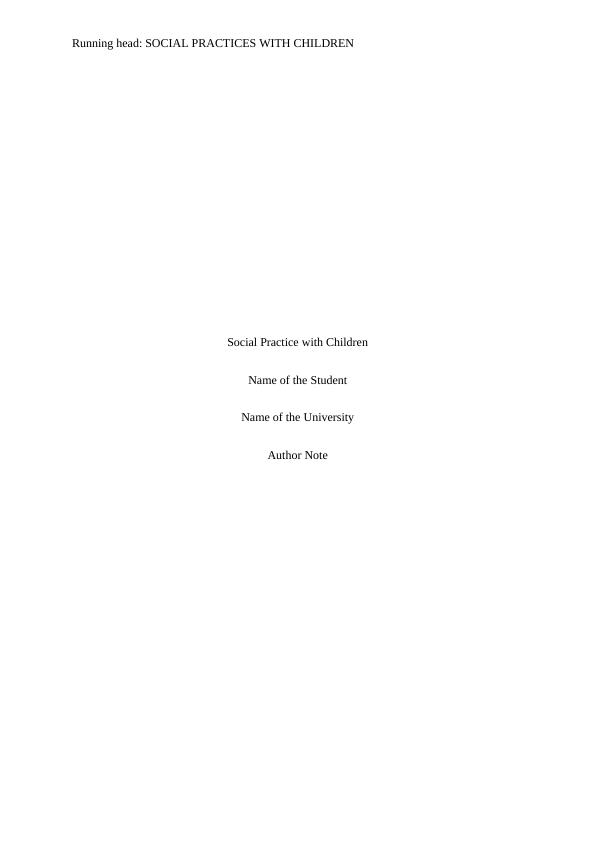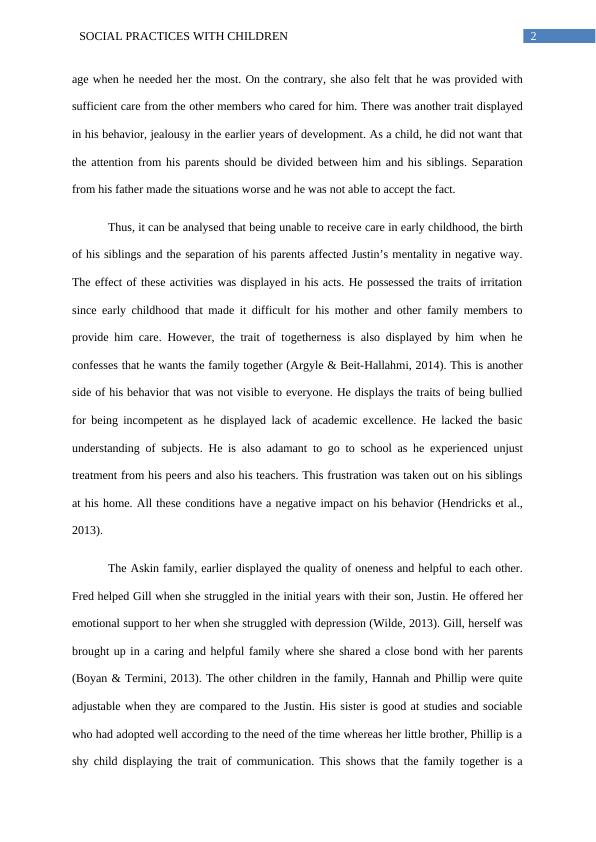Social Practices with Children
Added on 2023-03-30
8 Pages2053 Words205 Views
Running head: SOCIAL PRACTICES WITH CHILDREN
Social Practice with Children
Name of the Student
Name of the University
Author Note
Social Practice with Children
Name of the Student
Name of the University
Author Note

1SOCIAL PRACTICES WITH CHILDREN
The social systems theory aims at the social and physical wellness of the disciplines
that are related to the field of engineering and biology. They are the interrelated with the
theories that are practiced in the society. The social systems theory aims at the development
of the society by analyzing the effect of the stimuli on the receptive forces. The systems in
the society are either opened or closed that shows and evaluates their effect on them. They
aim to define the complex social structure and the interactions that occur within the social
system. The purpose of this theory is to ascertain the development of the social structure and
the relationships. The relationships in the society are important as they are helpful in
establishing a social model. They help to maintain balance in the society by creating an
equilibrium between the activities happening in the society. The different aspects are
described that can help in the achievement of goals in society. It is also highlighted that the
social systems theory helps in solving the problems in the society.
The case study of The Askin Family will be analyzed to assess the pattern of behavior
displayed by their 12 year old son Justin. The behavioral patterns that are displayed by Justin
and the factors that influence his behavior. The factor that triggered his aggressive behavior
was the separation of his father, Fred from his mother, Gill. The fact that he was now
separated from his father with whom he shared a special bond was painful. This created
frustration in him that led to harsh and rude behavior. It was experienced by his sisters as well
as his friends that led to his rustication from the school. The reliability that he had on his
family was lacking as the only member he was associated with was not there. The aggressive
behavior he displayed was due to the distance he was experiencing from his father
(Gherasim, 2013). It was also due to the lack of motherly care that he deserved in his
childhood. Childhood is the phase where an individual requires most of the care. Justin did
not receive that care as his mother had to admit him to childcare center due to professional
commitments. His mother has a sense of guilt of not being able to provide care to him at the
The social systems theory aims at the social and physical wellness of the disciplines
that are related to the field of engineering and biology. They are the interrelated with the
theories that are practiced in the society. The social systems theory aims at the development
of the society by analyzing the effect of the stimuli on the receptive forces. The systems in
the society are either opened or closed that shows and evaluates their effect on them. They
aim to define the complex social structure and the interactions that occur within the social
system. The purpose of this theory is to ascertain the development of the social structure and
the relationships. The relationships in the society are important as they are helpful in
establishing a social model. They help to maintain balance in the society by creating an
equilibrium between the activities happening in the society. The different aspects are
described that can help in the achievement of goals in society. It is also highlighted that the
social systems theory helps in solving the problems in the society.
The case study of The Askin Family will be analyzed to assess the pattern of behavior
displayed by their 12 year old son Justin. The behavioral patterns that are displayed by Justin
and the factors that influence his behavior. The factor that triggered his aggressive behavior
was the separation of his father, Fred from his mother, Gill. The fact that he was now
separated from his father with whom he shared a special bond was painful. This created
frustration in him that led to harsh and rude behavior. It was experienced by his sisters as well
as his friends that led to his rustication from the school. The reliability that he had on his
family was lacking as the only member he was associated with was not there. The aggressive
behavior he displayed was due to the distance he was experiencing from his father
(Gherasim, 2013). It was also due to the lack of motherly care that he deserved in his
childhood. Childhood is the phase where an individual requires most of the care. Justin did
not receive that care as his mother had to admit him to childcare center due to professional
commitments. His mother has a sense of guilt of not being able to provide care to him at the

2SOCIAL PRACTICES WITH CHILDREN
age when he needed her the most. On the contrary, she also felt that he was provided with
sufficient care from the other members who cared for him. There was another trait displayed
in his behavior, jealousy in the earlier years of development. As a child, he did not want that
the attention from his parents should be divided between him and his siblings. Separation
from his father made the situations worse and he was not able to accept the fact.
Thus, it can be analysed that being unable to receive care in early childhood, the birth
of his siblings and the separation of his parents affected Justin’s mentality in negative way.
The effect of these activities was displayed in his acts. He possessed the traits of irritation
since early childhood that made it difficult for his mother and other family members to
provide him care. However, the trait of togetherness is also displayed by him when he
confesses that he wants the family together (Argyle & Beit-Hallahmi, 2014). This is another
side of his behavior that was not visible to everyone. He displays the traits of being bullied
for being incompetent as he displayed lack of academic excellence. He lacked the basic
understanding of subjects. He is also adamant to go to school as he experienced unjust
treatment from his peers and also his teachers. This frustration was taken out on his siblings
at his home. All these conditions have a negative impact on his behavior (Hendricks et al.,
2013).
The Askin family, earlier displayed the quality of oneness and helpful to each other.
Fred helped Gill when she struggled in the initial years with their son, Justin. He offered her
emotional support to her when she struggled with depression (Wilde, 2013). Gill, herself was
brought up in a caring and helpful family where she shared a close bond with her parents
(Boyan & Termini, 2013). The other children in the family, Hannah and Phillip were quite
adjustable when they are compared to the Justin. His sister is good at studies and sociable
who had adopted well according to the need of the time whereas her little brother, Phillip is a
shy child displaying the trait of communication. This shows that the family together is a
age when he needed her the most. On the contrary, she also felt that he was provided with
sufficient care from the other members who cared for him. There was another trait displayed
in his behavior, jealousy in the earlier years of development. As a child, he did not want that
the attention from his parents should be divided between him and his siblings. Separation
from his father made the situations worse and he was not able to accept the fact.
Thus, it can be analysed that being unable to receive care in early childhood, the birth
of his siblings and the separation of his parents affected Justin’s mentality in negative way.
The effect of these activities was displayed in his acts. He possessed the traits of irritation
since early childhood that made it difficult for his mother and other family members to
provide him care. However, the trait of togetherness is also displayed by him when he
confesses that he wants the family together (Argyle & Beit-Hallahmi, 2014). This is another
side of his behavior that was not visible to everyone. He displays the traits of being bullied
for being incompetent as he displayed lack of academic excellence. He lacked the basic
understanding of subjects. He is also adamant to go to school as he experienced unjust
treatment from his peers and also his teachers. This frustration was taken out on his siblings
at his home. All these conditions have a negative impact on his behavior (Hendricks et al.,
2013).
The Askin family, earlier displayed the quality of oneness and helpful to each other.
Fred helped Gill when she struggled in the initial years with their son, Justin. He offered her
emotional support to her when she struggled with depression (Wilde, 2013). Gill, herself was
brought up in a caring and helpful family where she shared a close bond with her parents
(Boyan & Termini, 2013). The other children in the family, Hannah and Phillip were quite
adjustable when they are compared to the Justin. His sister is good at studies and sociable
who had adopted well according to the need of the time whereas her little brother, Phillip is a
shy child displaying the trait of communication. This shows that the family together is a

End of preview
Want to access all the pages? Upload your documents or become a member.
Related Documents
MSWPG7107 Social work practice with childrenlg...
|11
|1993
|91
Social Work Practicelg...
|7
|2472
|60
MSWPG 7107 Social Work With Children, Young People and Familieslg...
|11
|2864
|234
Hypothetical Case Study on Child Development and Ecological Perspectivelg...
|11
|2922
|403
Social Work Practice with Children, Young People and Familieslg...
|9
|2515
|258
Healthcare Administration - PDFlg...
|17
|5115
|93
